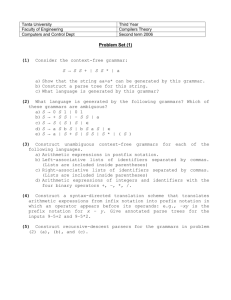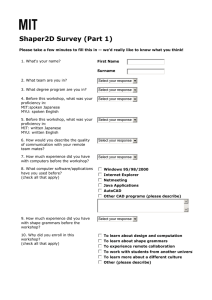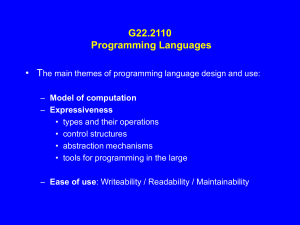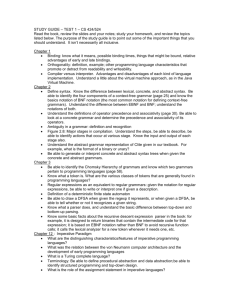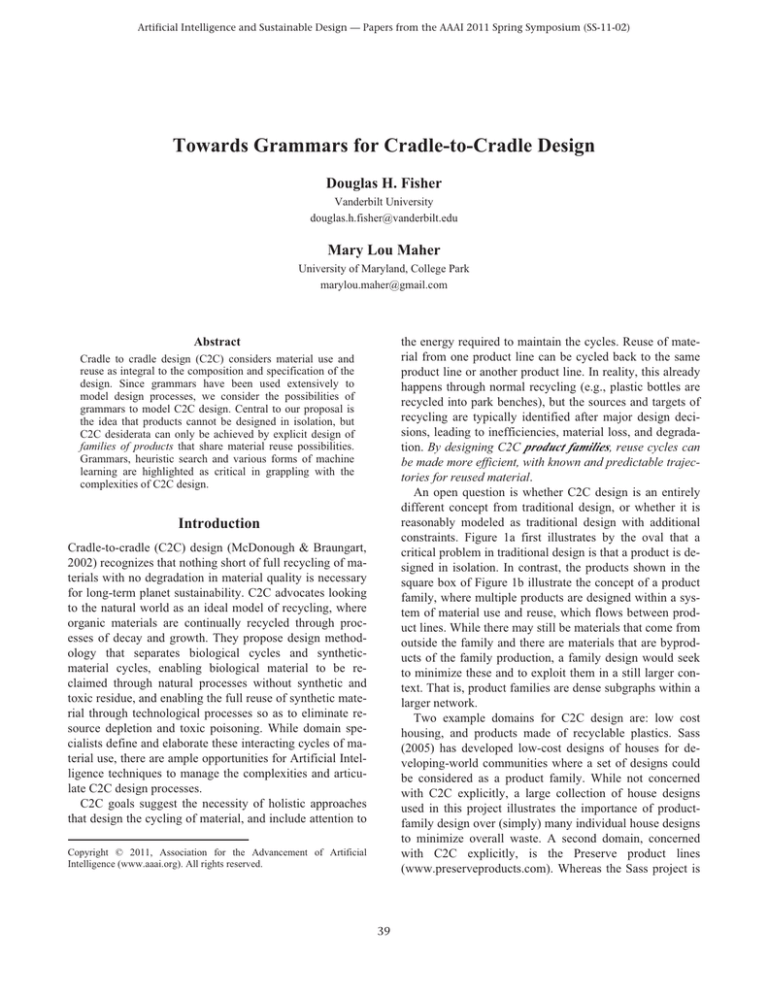
Artificial Intelligence and Sustainable Design — Papers from the AAAI 2011 Spring Symposium (SS-11-02)
Towards Grammars for Cradle-to-Cradle Design
Douglas H. Fisher
Vanderbilt University
douglas.h.fisher@vanderbilt.edu
Mary Lou Maher
University of Maryland, College Park
marylou.maher@gmail.com
the energy required to maintain the cycles. Reuse of material from one product line can be cycled back to the same
product line or another product line. In reality, this already
happens through normal recycling (e.g., plastic bottles are
recycled into park benches), but the sources and targets of
recycling are typically identified after major design decisions, leading to inefficiencies, material loss, and degradation. By designing C2C product families, reuse cycles can
be made more efficient, with known and predictable trajectories for reused material.
An open question is whether C2C design is an entirely
different concept from traditional design, or whether it is
reasonably modeled as traditional design with additional
constraints. Figure 1a first illustrates by the oval that a
critical problem in traditional design is that a product is designed in isolation. In contrast, the products shown in the
square box of Figure 1b illustrate the concept of a product
family, where multiple products are designed within a system of material use and reuse, which flows between product lines. While there may still be materials that come from
outside the family and there are materials that are byproducts of the family production, a family design would seek
to minimize these and to exploit them in a still larger context. That is, product families are dense subgraphs within a
larger network.
Two example domains for C2C design are: low cost
housing, and products made of recyclable plastics. Sass
(2005) has developed low-cost designs of houses for developing-world communities where a set of designs could
be considered as a product family. While not concerned
with C2C explicitly, a large collection of house designs
used in this project illustrates the importance of productfamily design over (simply) many individual house designs
to minimize overall waste. A second domain, concerned
with C2C explicitly, is the Preserve product lines
(www.preserveproducts.com). Whereas the Sass project is
Abstract
Cradle to cradle design (C2C) considers material use and
reuse as integral to the composition and specification of the
design. Since grammars have been used extensively to
model design processes, we consider the possibilities of
grammars to model C2C design. Central to our proposal is
the idea that products cannot be designed in isolation, but
C2C desiderata can only be achieved by explicit design of
families of products that share material reuse possibilities.
Grammars, heuristic search and various forms of machine
learning are highlighted as critical in grappling with the
complexities of C2C design.
Introduction
Cradle-to-cradle (C2C) design (McDonough & Braungart,
2002) recognizes that nothing short of full recycling of materials with no degradation in material quality is necessary
for long-term planet sustainability. C2C advocates looking
to the natural world as an ideal model of recycling, where
organic materials are continually recycled through processes of decay and growth. They propose design methodology that separates biological cycles and syntheticmaterial cycles, enabling biological material to be reclaimed through natural processes without synthetic and
toxic residue, and enabling the full reuse of synthetic material through technological processes so as to eliminate resource depletion and toxic poisoning. While domain specialists define and elaborate these interacting cycles of material use, there are ample opportunities for Artificial Intelligence techniques to manage the complexities and articulate C2C design processes.
C2C goals suggest the necessity of holistic approaches
that design the cycling of material, and include attention to
Copyright © 2011, Association for the Advancement of Artificial
Intelligence (www.aaai.org). All rights reserved.
39
a product family of same-type products (i.e., low-cost
houses), the Preserve line is heterogeneous, containing
many different kinds of products.
non-terminal symbols, to a sequence of only terminal symbols. A sentential form is an intermediate set of symbols
obtained through a sequence of zero or more productions,
beginning with the start symbol.
There is a rich history of using grammars to describe design knowledge generally in AI. In particular, shape
grammars (Stiny 2008, 1980; Stiny and Gips 1972; Knight,
1998) are a variant on context free grammars (CFG) that
include shape rewrite rules that can be applied in a step-bystep manner to generate a set of designs. An example of a
grammar for designing virtual worlds is described in Gu
and Maher (2004). Shape grammars have developed over
the years to include many extensions, such as parametric
grammars, color grammars, description grammars, structure grammars, parallel grammars, and so on, to address
different aspects of designs.
Knight (1999) proposes at least two approaches to developing a grammar-based system that produces designs
meeting specified goals under constraints. A strictly generative approach incorporates knowledge into grammar
rules so that all generated designs satisfy the constraints. In
a generate-and-test approach the grammar is underconstrained, and the initially generated designs are examined using an evaluation function for those that satisfy the
constraints. Naturally, there need not be a hard schism between strictly generative and generate-and-test methods –
even if all hard constraints can be encoded in the grammar,
there will likely still be preferences that are best captured
in an evaluation function. In general, the space of grammar-based design methods extends with constraint-based
and optimization methods, and hybrids of them.
We propose to adapt grammar-based approaches to C2C
design by (a) defining grammars for languages of product
family designs rather than languages of individual product
designs, (b) defining constraints and preference functions
for ranking product family designs by their amenability to
C2C principles (manufacture, use, disassembly and reuse),
and (c) taking steps through both first-principle analysis
and machine learning techniques towards strong(er) grammars with derivations to strings that satisfy many of the
hard constraints and perhaps even some preferences.
Figure 1: Traditional design vs C2C design.
Design Grammars
When considering the role of AI in sustainable design, we
start with grammars as a formal language that can describe,
generate, and/or check for C2C design. By starting with a
grammar as descriptive of C2C design, we begin to formalize the principles of C2C design as a language, which can
also be used to generate example C2C designs. Our focus
is on the design of product families and the subordinate designs of individual products, to include lifecycle concerns.
We assume that the reader understands the basics of
grammars, so we only review terminology. A grammar is a
finite specification of a possibly infinite set of strings (or
language) – in this case, each terminal string (or henceforth, simply string) is a sequence of terminal symbols or
members of an alphabet; for now, each string represents a
product design, but in subsequent sections a string will
correspond to a product family. A string is a technical term
that refers to the terminal symbols and may include symbols that separate one product from another. A grammar is
specified by a set of terminal symbols, a set of nonterminal symbols, and a set of productions (aka rewrite
rules) of the form α β, where α and β are collections of
terminal and non-terminal symbols. In the case of a context–free grammar, α is always a single non-terminal symbol and β can be any finite sequence of symbols. A derivation is defined by a sequence of transitions from a specially-designated start symbol, which is a member of the
Grammars for Product Design
We initially make some important simplifying assumptions. Foremost, we assume that a product is only represented by its material components. Each terminal symbol
represents ‘one unit’ of material, so the string ‘aabbbc’ represents a product with two units of material ‘a’, three units
of ‘b’, and one of ‘c’. With reference to Figure 1, this assumption would translate to replacing each label (e.g.,
‘Product A’) by a string (e.g., ‘aabbbc’).
40
Continuing, we assume that each non-terminal symbol
defines a (sub)language of product components -- the start
symbol of the grammar is a special case, defining the language of products. Putting this together with our assumptions about the representation of a product, we might define a grammar for toothbrushes, with start symbol T and
productions:
ple, we imagine a possibility in which standards for product grammars are established, and automated means are
developed that find patterns across these product grammars
in search of desirable product families. The base grammars
over which this search occurs can be bootstrapped from existing products. For each product, a grammar can be induced for which that product is but one string. By analyzing the composite structure of the product, non-terminal
symbols can be introduced that reflect an aspect of the
composition, with at least one production enabling eventual derivation of the product, but with other productions
leading to other, functionally equivalent or very similar
products. These new strings might, for example, be composed of different materials than the ‘seed’ product, where
functionally and physically related materials would be encoded as background knowledge. This strategy would be
an analytic form of generalization from very limited data
that was akin to explanation-based learning (DeJong and
Mooney, 1986; Yoo and Fisher, 1991) and experimental
goal regression (Porter and Kibler, 1986).
T Handle Head
Handle Grip Back
Head Base Bristles
Grip aa
Grip ab
Grip aba
Back bb
Back b
Base b
Bristles c
One (leftmost) derivation in this grammar is
T Handle Head
(using T Handle Head)
Grip Back Head
(using Handle Grip Back)
aa Back Head
(using Grip aa)
aa bb Head
(using Back bb)
aa bb Base Bristles (using Head Base Bristles)
aa bb b Bristles
(using Base b)
aa bb b c
(using Bristles c)
Weak Grammars for Product Family Design
A grammar for a language of product families can be constructed from other grammars for product languages. For
example, suppose that we have a grammar that defines a
set (language, class) of toothbrushes, any one of which is a
possible product/artifact; the start symbol for this grammar
is T. Suppose that we also have a grammar defining a language of hairbrushes, with start symbol H. A language of a
product family designs that include hairbrush and toothbrush products is defined by
Note that ‘ababbc’ is derivable, as well as ‘aabbbc’, and
whether these were regarded as ‘equivalent’ or not would
be judged by a preference function.
The grammar above is context free, but context sensitive
transitions might also be introduced. For example, if it was
desirable that the total amount of material derived from
Back was sensitive to the amount derived from Grip, then
productions such as
S [T] [H]
Assuming that derivations starting with T and H produce
exactly one (non-NIL) terminal product each, the grammar
with start symbol S defines a language of product pairs, of
one toothbrush and one hairbrush per terminal product
family. Delimiters such as ‘[‘ and ‘]’ may be retained
throughout a derivation and in the final terminal strings,
but such boundaries might also be removed/ignored, allowing product sentential forms to be interleaved at various
points in a product family derivation.
Instead of the production above, we could introduce new
productions
aba Back aba b
aa Back aa bb
ab Back ab bb
might be used instead of the context-free Back rules (here,
we ignore the possible reorganization of a grammar so as
to eliminate context sensitive rules, resulting in another
context free grammar).
In design grammars generally, there is attention to representing connections between components in the grammar
and in derivations. We have thus far not addressed issues
of component connectedness, but rather viewed a product
as simply a bag of materials.
While these assumptions are very limiting, they still allow progress on developing a framework for C2C design
grammars and methods for their development. For exam-
S SS
S [T]
S [H]
41
Together with the productions given in the constituent
grammars, this new grammar defines a language of product
families of hairbrushes and toothbrushes with at least one
toothbrush or at least one hairbrush. It allows product families with duplicate products (e.g., 2 instances of a particular
toothbrush ti and 3 instances of a particular hairbrush hk.
The language also allows for families that contain only
toothbrushes or only hairbrushes.
In the case of duplicates, the cardinality of differing
product (duplicates) could be interpreted as a proportionality specification (e.g., in a product family there is a 2/3 the
number of ti as there are of hk), which could be relevant for
resource planning and the like.
A grammar for a product family defines an infinite set of
product combinations and duplicate cardinalities. The size
of the terminal strings (aka families) can be bound to a finite value, which also bounds the precision of product proportionalities (e.g., bounding family size to 5 or less allows
2/3 of ti to hk but disallows an expression of 4/5 of ti to hk);
the size of the language may remain infinite, even with
such a bound on family size, if any of the constituent
grammars define infinite languages.
Having defined a product family grammar as just described, it is obvious that this too could be a constituent
grammar in a still ‘larger’ grammar and that the product
family could be a terminal in a still larger and richly organized language of product collectives. Nonetheless, our examples, for now, will correspond to the intuition that we
have grammars for ‘individual products’, from which we
can construct grammars for product families. In building
composite grammars from constituent grammars, we assume that terminal and non-terminal symbols that have the
same names in different constituent grammars are the same
materials in the case of terminals and represent the same
component sets in the case of non-terminals. Thus, care
must be taken to standardize apart symbols across constituent grammars if such symbols represent different sets. If
constituent grammars share terminal and non-terminal
symbols, this presents opportunities for reorganization of
the composite grammar to more explicitly represent possible interactions between product derivations within a
product family.
We return to Figure 1b at this point, to illustrate some of
our assumptions. Figure 1b, without the arcs, and with
product labels in the boxes replaced by strings of material
units (e.g., ‘aabbbc’ for Product A, ‘addeeef’ for Product
B, ‘bcdddee’ for Product D) is an instance of a product
family. Figure 2 explicitly shows such a structure, which
would be a string resulting from a derivation in a product
family grammar.
Figure 2: A product family under simplifying assumptions
Constraints and Preferences
In the previous two sections we have seen that grammars
can be constructed for generating and describing both
product designs and product family designs. That is,
grammars define a search space. Now we turn our attention
to constraints and preferences that can be used to evaluate
product family designs. As such, they can also be used to
guide the search for product family designs. Hard constraints define whether designs are acceptable or not. Preferences define the desirability of some designs over others.
We begin discussion of constraints and preferences by
considering families composed of existing product designs
only. This is an activity that tenacious recyclers might perform; looking as best they can for relationships between
existing products – grouping products designs together in a
way that maximizes recycled material with minimal cost
(e.g., energy). Given our assumptions, each and every
product design would be represented as a vector of materials and essentially an integer amount of each material.
Given the huge space of all such represented product designs (e.g., ‘abbbcc’, aaabddee’, bdefff’, …), we could apply unsupervised learning methods of clustering (Fisher,
2002) to group product designs, optimizing a tradeoff between maximizing within-family overlap in material shared
among product designs and minimizing between-family
overlap in shared material. Though the product family representation we are currently considering does not include
arcs showing material flow trajectories, the intent of
maximizing within and minimizing between family material overlap can be mapped to maximizing recycled content
at minimal cost.
42
So-called constrained clustering (Basu et al, 2008) allows analysts to impose constraints that require that some
objects (product designs) be grouped together, while requiring that other products not be. For example, analysts
might know that certain materials are highly toxic in a way
that cannot be easily controlled during reclamation, therefore indicating that such materials be separated entirely
from product designs that can undergo routine reclamation.
Other constraints and preferences that can be used to design product families as clusters of existing products could
be based on expected lifetimes of existing products, generating families in which time spans can be coordinated to
better insure material replenishment, or methods (and their
costs) of returning products to be recycled at the end of life
– we would want to favor products that can be packaged
together for example, thereby minimizing transportation
energy. These preferences and constraints all arise from
externalities, and absent an ability to explicitly represent
certain constraint and preference knowledge in the grammar, it would remain in the evaluation function.
Preferences and constraints that are useful for evaluating
families of existing products, are also presumably useful
for guiding the search for entirely new product designs,
and in our case this search is embedded in a search of
product families. Moreover and importantly, C2C constraints and preferences can be encoded into grammar rules
or preference functions so as to exclude new designs that
violate C2C principles. For example, McDonough and
Braungart (2002) talk about ‘monstrous hybrids’, which
are products that combine synthetic and organic material to
the detriment of recycling either effectively. To a large extent we imagine that monstrous hybrids can be excluded by
suitable crafting of production rules of constituent product
grammars.
More generally, in addition to preferences and constraints applied to a string (i.e., product or product family),
constraints and preferences can be functions of the string
derivations, represented as a sequence or as a parse tree.
While a design-grammar derivation need not map directly
to manufacturing and/or disassembly steps of the terminal
product of the derivation, it is a natural bias to consider the
grammar as constructive. Indeed, if we assume a mapping
between grammar derivations and steps of manufacturing,
as well as disassembly procedures, then costs associated
with these activities can be reflected in an augmented
grammar. Costs could correspond to represent energy; they
could also represent materials used as positive costs and
reclaimed as negative costs, or rewards.
For simplicity, we restrict ourselves to the case where
disassembly is the inverse of construction, and production
is associated with a forward cost (e.g., representing a constructive step) and a backward cost (e.g., representing a
disassembly step). In general, the backward and forward
costs may be quite different. Under these assumptions, a
preference function for designs is informed by the derivations for those designs, and in particular, costs associated
with those derivations. Because costs are associated with
individual productions, sentential forms at intermediate
points can be evaluated, and used to guide a heuristic
search through the space of possible derivations. In the
simplest case, the sum of forward and backward derivation
costs would be a factor in evaluating proposed product
families.
Challenges Ahead
From constituent grammars for product languages, each
augmented with production costs, we can define cost augmented grammars for product family languages. But in the
weak approach outlined in the previous section, the evaluative cost of a product family would necessarily be a simple
summation over the total forward and backward costs
across the products in a family. There are substantive challenges in defining grammars for product family designs
that more tightly couple the constituent grammars for individual product designs. Put another way, we want grammars that capture the rich interactions between product designs suggested by Figure 1b.
An approach that we are considering, with machine
learning at the heart of it, is to transition from weak to
strong methods. Recall that a weak generate-and-test
method is one in which the grammar is under-constrained,
defining a language that is a large superset of the C2C designs. Designs that are found/generated during search are
subjected to an evaluation function that encodes constraints
and preferences; constraints eliminate those that violate
principles of C2C design, and preferences serve to rank the
surviving strings.
In contrast, the strongest methods are those in which a
grammar derives only strings that satisfy the principles of
C2C design; these are the strictly generative approaches
described by Knight (1998). Designs stemming from
strong methods would likely still be evaluated by preferences for choosing among C2C designs.
As a rule it is much easier to formalize a weak method
than a strong method for complicated domains. In fact, as
we have mentioned early on, methods span a continuum
between the weakest and strongest methods; machine
learning can traverse this continuum. Thus, a cost-effective
strategy for obtaining methods at the strong end of the
spectrum is to first specify a weak method, to include an
under-constrained grammar plus preferences and constraints. The weak grammar defines a search space, and
machine learning of search control knowledge, which is a
form of speedup learning (Yoo and Fisher, 1991), transforms the system to the strong method that is more desired.
43
We believe that this automated learning approach, which
backs up constraints and preferences into the generator is a
promising future component in a grammar based framework for C2C design.
Wackernagel M. and Rees W. 1996. Our Ecological Footprint:
Reducing Human Impact on the Earth, New Society Publishers.
Yoo, J., & Fisher, D. 1991. Concept formation over explanations
and problem-solving experiences. Proceedings of the International Joint Conference on Artificial Intelligence, Sydney, Australia: Morgan Kaufmann, 630--636.
Acknowledgments. We acknowledge the information
available on the Preserve.com web site about their C2C
products and a discussion with Christie Lee at Preserve
about their approach to designing products with reusable
plastics.
References
Basu, S., Davidson, I., and Wagstaff, K. 2008. Constrained Clustering. Chapman & Hall.
DeJong, G. and Mooney, R. 1986. Explanation-based Learning:
An Alternative View. Machine Learning. 1:145-176
Fisher, D. H. 2002. Conceptual Clustering. In W. Klosgen and J.
Zytkow (eds) Handbook of Data Mining and Knowledge Discovery. Oxford, UK: Oxford University Press, pp. 388-396.
Gu, N. and Maher, M.L. 2004. A Grammar for the Dynamic Design of Virtual Architecture Using Rational Agents, International
Journal of Architectural Computing, 4(1): 489-501.
Knight, T.W. 1998. Shape Grammars. Environment and Planning
B: Planning and Design Anniversary Issue, pp. 86-91.
McDonough W and Braungart M. 2002. Cradle to Cradle, New
York: North Point Press.
Porter, B. and Kibler, D. 1986. Experimental Goal Regression: A
Method of Learning Problem Solving Heuristics. Machine Learning 1: 249-286.
Sass L. 2005. A Production System for Design and Construction
with
Digital
Fabrication,
MIT;
Cambridge,
MA/USA:http://ddf.mit.edu/projects/CABIN/cabin_mit_2005.pdf
Stiny, G. 2008. Shape: Talking about Seeing and Doing, MIT
Press.
Stiny G. 1980. Introduction to Shape Grammars, Environment
and Planning B 7:343-351.
Stiny G. and Gips J. 1972. Shape Grammars and the Generative
Specification of Painting and Sculpture, in C.V. Freiman (ed),
Proceedings of Information Processing 71, North Holland, Amsterdam, pp. 1460-1465.
44

